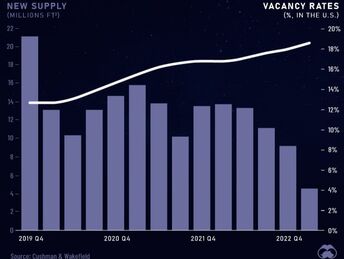Roll-Out-of-Bed CommutesA generation ago, the hour-long commute to work, followed by nine hours in an office, was a ubiquitous part of American life. But the rise of remote work has changed all that. Now, around 35% of U.S. workers who can work from home in 2023 are already doing so all the time, according to Pew Research Center. And this shift has left a lot of empty office space in its wake. San Francisco has been hardest hit, with vacancy rates climbing by 19.8 percentage points in just over three years. Even New York City, the metropolis that never sleeps, has seen its Midtown South region experience an increase of 14.2 percentage points. The Bigger Picture: Top 10 CitiesIn cities large and small, from the coast to the heartland, vacancy rates are climbing. The story is not confined to the giants like San Francisco and New York. Urban areas like Austin, Columbus, and Raleigh-Durham have seen massive increases in their office vacancies as well. But unlike larger cities where demand has fallen, their rising vacancy rates may be attributed more to new construction and oversupply. A ranking, based on data out of fDi Intelligence, of the cities with the fastest-growing vacancy rates from Q4’2019 to Q1’2023 paints a startling picture:
The Office Real Estate Market: An Uncertain FutureThe new office real estate market has been cooling since Q1’2022, down by a staggering 67% year-over-year. It's anticipated that by 2030, over 300 million square feet of U.S. office spaces will be obsolete. While this decline in demand represents a challenge, it also presents an opportunity for innovative solutions. Are there new ways to utilize these vacant spaces? Could urban areas be redesigned with a blend of residential and commercial usage? Are there business models that can thrive in this new environment? These questions are on the minds of city planners, developers, and entrepreneurs alike.  In a sense, these vacant office spaces are more than just empty buildings. They symbolize a broader transformation in the way people live and work. It's a change that brings challenges but also opens the door to innovation and new thinking. How America answers this new set of questions will define the economic landscape for generations to come. In the final analysis, the story of America's vacant offices is not one of decay but rather of evolution. It's a story that, like those empty buildings, is waiting to be filled with new ideas, new solutions, and new life. The cities that embrace this transformation themselves at the forefront of a new era in American life and commerce. The game is over and the players are only beginning to understand the new rules. AuthorCharles T. Peterson, IV
0 Comments
Your comment will be posted after it is approved.
Leave a Reply. |
Topics & Writers
All
AuthorsGreg Walters Archives
July 2024
|


